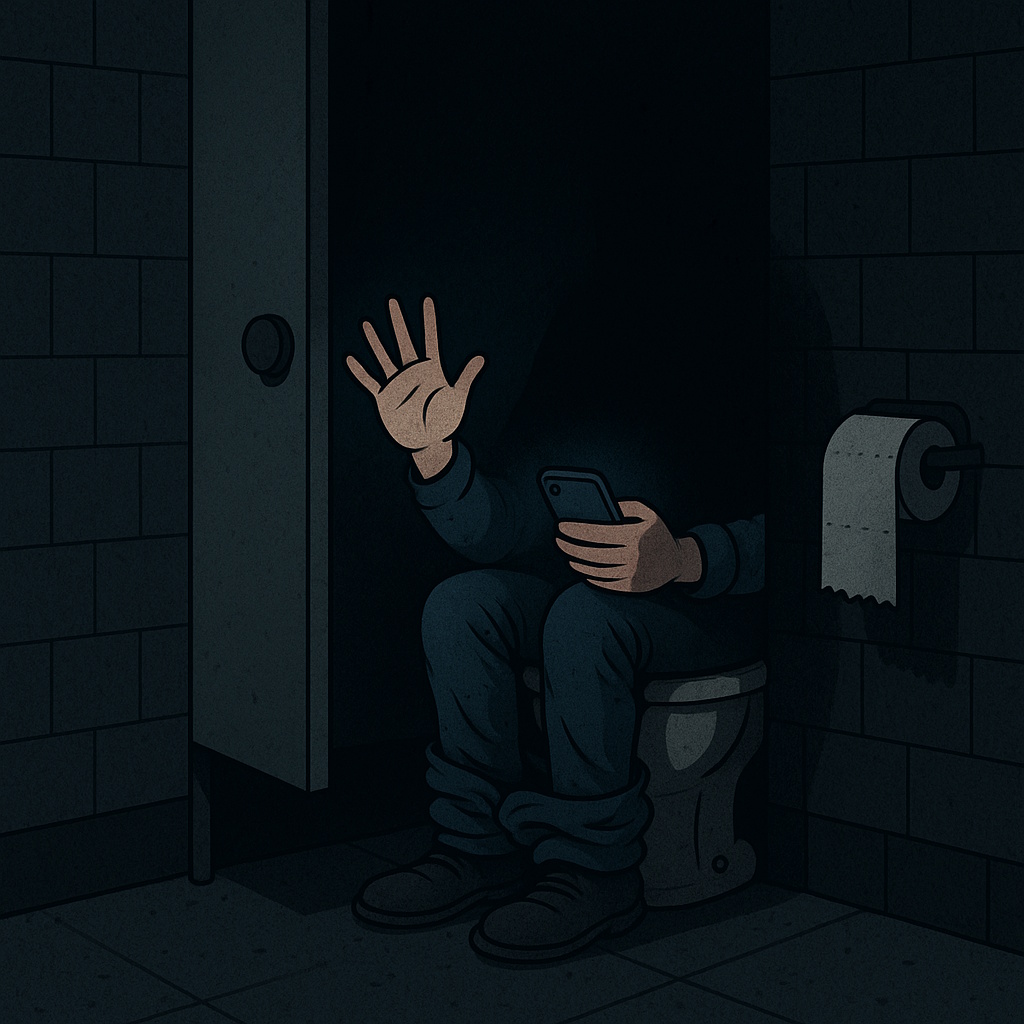It began, as all tragedies do, with optimism.
Colin from Accounts had just eaten an uninspiring Pret wrap and wandered to the office loo—armed with his phone, a sense of entitlement, and the noble dream of five undisturbed minutes. The world outside could wait. Emails could rot. He had entered that sacred temple of beige tiles and uncomfortable echoes to answer nature’s call, ideally at his own pace.
And then, precisely 2 minutes and 57 seconds into his porcelain pilgrimage, the lights went out.
Total darkness. No warning. No flicker. No “Just so you know I’m turning off” blink of courtesy. Just the swift extinguishing of hope, hygiene, and visual orientation.
Colin paused, pants around ankles, heart pounding faintly to the beat of the motion sensor’s betrayal.
A Brief History of Sensor-Based Injustice
At some point in the last decade, a facilities manager—possibly drunk on power and Dairylea Lunchables—decided that switches were too pedestrian. Instead, we now trust our most vulnerable moments to motion-activated lighting systems, those fickle electric sentinels whose job it is to determine whether or not we still exist.
And they have standards.
According to the anonymous engineer James threatened politely emailed, the standard toilet light timeout is “180 seconds of inactivity.” Inactivity, in this case, being defined as not flailing like you’re attempting semaphore through a locked cubicle door.
So if you’re quietly sitting—reading, reflecting, gently questioning your life choices—you’re invisible.
You are nothing to the sensor.
Colin’s Hour of Darkness
Trapped mid-process, Colin had three options:
- Call for help – unlikely, given the office’s culture of stoic emotional repression.
- Wipe, stand, and re-activate the sensor – a logistical ballet requiring balance, precision, and a bravery not seen since the zipline incident at last year’s team-building retreat.
- Wave hand wildly under stall door – easily misinterpreted by passers-by as either flirtation or distress.
He chose all three. In sequence. In silence.
No one came.
The Existential Implications
Why is the timeout so short? Who decided three minutes was the natural limit for bowel-based contemplation?
Is it a subtle productivity push? A quiet HR nudge to ensure no employee feels comfortable for longer than 180 seconds?
Or worse: a Facilities Department vendetta against “long-sitters”?
One theory (unconfirmed) suggests the sensors were calibrated by someone who’s never eaten fibre. Another posits that it’s a deliberate psychological tactic, designed to reinforce a culture of urgency, movement, and clenched restraint.
Proposed Solutions from Staff
- Installing a small disco ball to reflect movement inside each cubicle. (Denied due to “vibe risk.”)
- Rotating seats that keep the sensor happy while inducing nausea. (Shelved indefinitely.)
- Encouraging staff to practice “express evacuations”. (HR was reportedly very interested in this until they realised what it meant.)
One intern allegedly brought in a desk fan on a timer. We are watching him carefully.
Final Thoughts (In the Dark)
Colin eventually emerged, blinking into the light like a mole in Dockers chinos. His dignity may never fully recover.
So to whoever set the timer, wherever you are, we say this:
Extend the minutes. Be kind. A bowel is not a stopwatch.
And to our fellow stall-sitters, torch users, and mid-dump dancers in the dark—we see you. Even if the sensor doesn’t.
James Henshaw is a brooding Geordie export who swapped the industrial grit of Newcastle for the peculiar calm of Lincolnshire—though he’s yet to fully trust the flatness. With a mind as sharp as a stiletto and a penchant for science-tinged musings, James blends the surreal with the everyday, crafting blogs that feel like the lovechild of a physics textbook and a fever dream.
Equally at home dissecting the absurdities of modern life as he is explaining quantum theory with alarming metaphors, James writes with the wit of someone who knows too much and the irreverence of someone who doesn’t care. His posts are infused with a dark humour that dares you to laugh at the strange, the inexplicable, and the occasionally terrifying truths of the universe—whether it’s the unnerving accuracy of Alexa or the existential menace of wasps.
A figure of mystery with a slightly unsettling edge, James is the sort of bloke who’d explain the meaning of life over a pint, but only after a dramatic pause long enough to make you question your own existence. His wit cuts deep, his insights are sharp, and his ability to make the surreal feel strangely plausible keeps readers coming back for more.
Discover more from untypicable
Subscribe to get the latest posts sent to your email.
